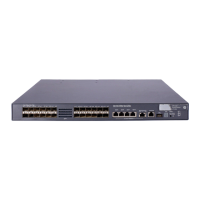196
NetStream data export
NetStream traditional data export
NetStream collects statistics of each flow and, when the entry timer expires, exports the data of each
entry to the NetStream server.
Though the data includes statistics of each flow, this method consumes more bandwidth and CPU, and
requires large cache size. In most cases, not all statistics are necessary for analysis.
NetStream aggregation data export
NetStream aggregation merges the flow statistics according to the aggregation criteria of an aggregation
mode, and sends the summarized data to the NetStream server. This process is the NetStream
aggregation data export, which decreases the bandwidth usage compared to traditional data export.
For example, the aggregation mode configured on the NDE is protocol-port, which means to aggregate
statistics of flow entries by protocol number, source port and destination port. Four NetStream entries
record four TCP flows with the same destination address, source port and destination port but different
source addresses. According to the aggregation mode, only one NetStream aggregation flow is created
and sent to the NetStream server.
Table 6 li
sts the 9 aggregation modes. In each mode, the system merges flows into one aggregation flow
if the aggregation criteria are of the same value. These 9 aggregation modes work independently and
can be configured on the same interface.
Table 6 NetStream aggregation modes
Aggregation mode
Aggregation criteria
Protocol-port aggregation
• Protocol number
• Source port
• Destination port
Source-prefix aggregation
• Source AS number
• Source address mask length
• Source prefix
• Inbound interface index
Destination-prefix aggregation
• Destination AS number
• Destination address mask length
• Destination prefix
• Outbound interface index
Prefix aggregation
• Source AS number
• Destination AS number
• Source address mask length
• Destination address mask length
• Source prefix
• Destination prefix
• Inbound interface index
• Outbound interface index

